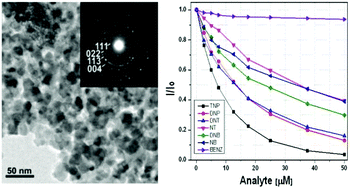Ultra-high sensitivity of luminescent ZnCr2O4 nanoparticles toward nitroaromatic explosives sensing†
Abstract
Here, we report the luminescence based sensing of trace amounts of nitroaromatic explosive organic compounds. The luminescence emission of nanosized spinel oxide ZnCr2O4 with high chemical and thermal stabilities has been used as a potential probe to detect such organic explosives. Low temperature solution combustion synthesized ZnCr2O4 oxide with an average particle size of ∼9 nm exhibits strong luminescence emission at 410 nm upon excitation at 260 nm in an aqueous suspension. The presence of nitroaromatics in ZnCr2O4 suspension dramatically suppresses the luminescence emission providing an opportunity to detect it quantitatively. The detection limit for 2,4,6-trinitrophenol (TNP) is as low as 23 ppb. A number of organic compounds have been investigated for a comprehensive understanding. The astonishing sensitivity of ZnCr2O4 nanoparticles towards nitro explosives is appealing for sensing application. A plausible explanation of such luminescence quenching has been ascribed to a two-fold mechanism. The underling mechanism is further substantiated by a similar study on ZnO nanoparticles.



 Please wait while we load your content...
Please wait while we load your content...